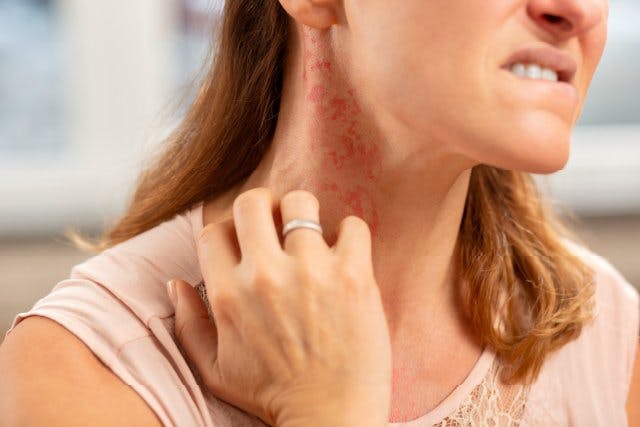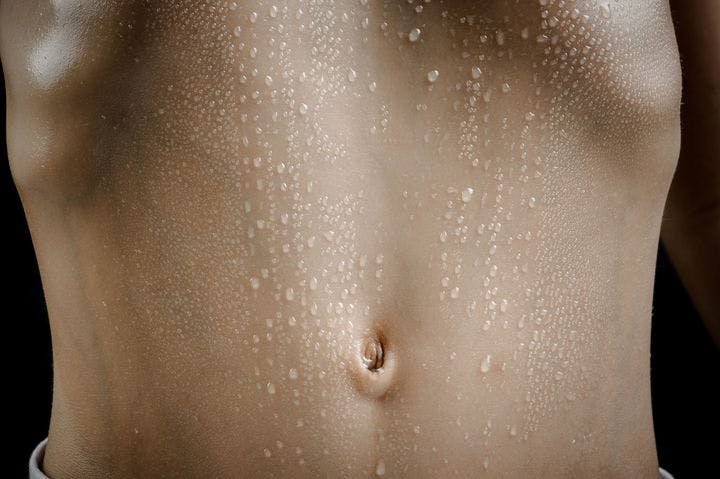4 Types of Neck Rashes and How to Treat Them
Published | 6 min read
Be it from the weather or an infection, neck rashes can bring a lot of pain and discomfort. Identify what causes these rashes and how you can treat them.

Different infections can cause a neck rash. A mild episode can be treated with simple home remedies, but some types of rashes may require medical attention.
Getting a neck rash right before an important date or event can be itchy, annoying, and uncomfortable. Its appearance and level of discomfort you feel depends on the cause of the rash. It can develop on your neck in different shades of brown, red, or purple. It may feel itchy, hot, painful, and may be accompanied by spots, bumps, scaly skin, or blisters.
Here is everything you need to know about some possible causes and how to treat a neck rash using natural remedies.
What are the Most Common Causes of a Neck Rash?
A neck rash is a common skin condition that is attributed to allergies. It can also be caused by stress, contact dermatitis, atopic dermatitis or eczema, psoriasis, autoimmune diseases such as systemic lupus erythematosus (SLE), and bacterial, fungal, viral or parasitic infections.
Practitioners of Traditional Chinese Medicine (TCM) believe that people with two specific body types – Yin Deficiency and Damp-Heat constitution – are more prone to a neck rash than others.
“A shortage of passive (yin) energy prevents the regulation of body temperature, making you prone to a neck rash. Pathogenic factors like Dampness and Heat can restrict your Liver and Spleen’s ability to function properly, which leads to the same outcome.”
Real Health Medical TCM Physician Kelvin Goh
Bacterial infections
Some types of bacteria live on human skin but don’t do any damage to your body. However, infections can occur if you have a cut, open wound, or broken skin.
One type of bacterial skin condition is impetigo, which is caused by a bacteria called Group A Streptococcus. Symptoms will become noticeable within one to three days and appear as small, itchy red spots. These spots will turn into blisters that ooze fluid and form a crust when they start to heal. Your lymph nodes may also swell, but you won’t have a fever.
Another skin infection worth knowing is methicillin-resistant Staphylococcus aureus (MRSA), which manifests from broken skin, especially in hairy areas. MRSA causes fever and appears as red and swollen skin bumps that are warm and painful to the touch. These bumps may also contain bacteria-filled pus or fluid.
Fungal infections

Anyone can get a neck fungal rash but it’s more common if you:
- Experience urinary incontinence
- Sweat heavily or break out in sweat easily
- Are undergoing chemotherapy
- Are using new skincare products
- Are taking antibiotics long-term or on a high dose
- Have a weak immune system or a disease that weakens your immune system
A fungal rash called tinea versicolor develops from the excessive growth of a specific type of skin yeast. A large patch or patches of skin that are of a lighter or darker shade than your normal skin tone are the most prominent characteristic of the rash. You may also feel itchiness in the affected areas, especially in a hot environment.
Viral infections
A condition that causes neck rashes are viral infections. There are three ways a virus can trigger the appearance of a neck rash. The rash can be a by-product of skin damage, or your body’s immune response to the virus. It may also be a physical reaction to toxins that the virus produces.
Viruses with a skin rash as a common symptom are:
- COVID-19
- Hepatitis
- Chickenpox or Shingle
- Roseola infantum
- Human immunodeficiency virus (HIV)
- Hand, foot, and mouth disease (HFMD)
The rash appears as spots, bumps or blotches on your skin, and may itch.
Parasitic infections
It may sound like something out of a horror movie, but you could get a rash from a parasitic infection. Parasites are small worms or insects that dig their way into the skin to lay eggs. These organisms can also live off human blood.
Human itch mites can do both, triggering an itchy skin rash called scabies.
Treatment Options for a Neck Rash
Most neck rashes can be treated through basic home care. You can treat mild neck rashes with simple skin care practices as part of your primary care regimen. Avoid scrubbing your skin and applying cosmetic lotions or ointments directly on the rash as these may cause further irritation.
Use gentle cleansers and warm water instead to clean your skin. Pat dry the affected area and leave it exposed to air. Consider cleansing your skin with an invigorating oatmeal bath.
Calamine lotion or Hydrocortisone cream (1%) are available with or without a prescription and can also help soothe a neck rash.
Should you notice any of these signs, you must consult a healthcare provider immediately:
- If you suspect you have a tick bite
- Have joint pain, fever, or a sore throat
- Have a purple rash that looks similar to skin bruising
- Have streaks of redness, swelling, or very tender skin areas
- Are short of breath, feel tightness in the throat, and have a swollen face
Take the natural route
Try Honeysuckle (jin yin hua, 金银花), which has anti-bacterial properties and promotes good digestion. It also helps ease allergy symptoms by eliminating toxins and pathogens from the body.
To brew honeysuckle tea, steep six grams of dried honeysuckle into a pot and with 300 millilitres (ml) of water for 10 minutes before drinking.
Like honeysuckle, Chinese skullcap roots (huang qin, 黄芩) have the abilities to calm allergic reactions, get rid of pathogens, and cool the body.
Undergo traditional physical therapy
Another treatment to consider is cupping therapy, which Physician Goh advocates to:
- Ease muscle tension
- Regulate imbalances in the body
- Release excess qi and encourage the circulation of
Stagnant Qi
To suppress inflammation and remove Heat from the body, you can self-massage acupoints like qu chi (LI11, 曲池) and tai yuan (LU9, 太渊).
Try the tips and natural remedies outlined above and know when to seek medical assistance from a dermatologist to reduce neck rash episodes. Alternative remedies may help, provided you consult a TCM practitioner beforehand.
If you’d like to share other causes and treatments for a neck rash, tell us in the comments section below.
References
- Verywell Health. 2022. Why Do I Have a Rash on My Neck? [online] [Accessed 3 February 2023]
- New York State – Department of Health. Bacterial Skin Infections: Impetigo and MRSA. [online] [Accessed 3 February 2023]
- Cleveland Clinic. Skin Fungus. [online] [Accessed 3 February 2023]
- Cedars Sinai. Tinea Versicolor (Pityriasis Versicolor). [online] [Accessed 3 February 2023]
- Cleveland Clinic. Viral Exanthem Rash. [online] [Accessed 3 February 2023]
- PPSD. Parasitic Infections. [online] [Accessed 3 February 2023]
- Penn Medicine. Rash. [online] [Accessed 3 February 2023]
Share this article on
Was This Article Useful to You?
Reviews (3)
I have skin rash on my neck under my chin it is very itchy. I have applied many prescriptions creams including cortisone but it doesn’t help.
Thank you
Colors are not mere physical aspects of matter; indeed, they represent our perception of the world. Throughout history, colors have born a variety of symbolic meanings besides their aesthetic function. Colors can be attributed to many things, such as seasons, as we’ve mentioned in the “What is my seasonal palette?” quiz and the “Color Personality Test.” The “What color am I quiz” is another personality test that will determine how you perceive the world around you and how you can make the world a different place.
Different color quiz goals
As mentioned earlier, colors represent different meanings. Sometimes they are associated with heat; sometimes, they are signs of different ideologies, etc. For instance, the “color personality quiz” was based on how you appeal to others. However, in this color quiz, we take a more subjective approach. What color character are you? In this color article, we talk about two different things based on your personality color. First, what the world looks like from your standpoint, whether it is cruel or fair. Second, how can you influence the world based on your persona? Would you like to view the world as a battlefield or a market? Depending on your answers, one of the four colors below will be your personality color.
The results of the “What color am I?” quiz
There are four hues associated with different personality types: Gold, Blue, Red, and Black.
None is better than the others; in fact, each one has its advantages and disadvantages. Altogether, society is made of all tones and can’t go on without any of them. So here are the attributes of each color.
The Gold
“Often have you heard that told- all that glitters is not gold.” _Shakespeare.
Golden people:
These people are rare and precious indeed. They see the world as pure as snow, and they see the glass half full. They can also be considered humans with Midas’ hand, as they can turn the dust of despair into glorious gold. They seek opportunities to help others and wish no ill for anyone. Such people are golden, indeed.
Golden Role:
They do not influence the world with their heroic actions or by their power and money. These people glitter with philosophic illumination and epic ideals. They are not the best executives; still, they inspire many. A Golden person is not defined by glittering words but by integrity and candor.
The Blue
Blue is the symbol for infinity, the sky, the sea, and above all, liberty.
Blue individuals:
They are practical and down-to-earth. They are best at planning and devising strategies. Blue appears in the sky and the seas; nevertheless, it is the most abstract pigmentation of all. This shows that the true power of blue people resides in their logical reasoning. Therefore, blue people are great engineers, medical doctors, and managers who experience many scientific and financial breakthroughs.
Blue Contribution
Blue people are the backbone of society. They are great at setting and following rules. They have a utilitarian point of view of the world that makes them contribute to the community by their knowledge and financial resources. However, these people might take some unpleasant actions for the greater good.
The Red
What do blood, fire, and love have in common? They all see red.
Reds are rough
Red personality is furious and passionate about life. They perceive the world in a more emotional way than others. If you’re not their friend, you’re their foe. They either love you, or they hate you. They are most likely to take things personally. If others oppress the reds, they revolt and overthrow the tyrants because the red can’t stand tyranny.
Red deeds
The reds are the acumen comrades when you’re in need. Whether you’re in a bar fight or a civil war, your red friends will stand by your side till their last drop of blood. This personality type will not tolerate injustice and oppression and will defend what it holds dear against opposing threats. They also have great athleticism and sportsmanship.
It helped bc I have a rash on my jawline going to my neck so slay








